|
Jhansi
city, situated between the rivers Pahunj and Betwa is a symbol of
bravery, courage and self respect. It is said that in ancient times
Jhansi was a part of the regions Chedi Rashtra, Jejak Bhukit, Jajhoti
and Bundelkhand.
Jhansi was
a stronghold of the Chandela kings. Balwant Nagar was the name of this
place. But in 11th. century Jhansi lost its importance. In 17th.
century under Raja Bir Singh Deo of Orchha Jhansi again rose to
prominence. Raja Bir Singh Deo had good relations with the mughal
emperor Jehangir. In 1613 Raja Bir Singh Deo constructed the Jhansi
fort. He died in 1627. After his death his son Juhar Singh succeeded
him.
Maharaja
Chattrasal Bundela of Panna was a good administrator and a brave
warrior. In 1729 Mohammed Khan Bangash attacked Chattrasal. Peshwa
Baji Rao(I ) helped Maharaja Chattrasal and defeated mughal army. As a
mark of gratitude Maharaja Chattrasal offered a part of his state to
Maratha Peshwa Baji Rao(I). Jhansi was also included in this part.
In 1742
Naroshanker was made the subedar of Jhansi. During his tenure of 15
years he not only extended the Jhansi fort which was of strategic
importance but also constructed some other buildings. The extended
part of the fort is called Shankergarh. In 1757 Naroshanker was called
back by the Peshwa. After him Madhav Govind Kakirde and then Babulal
Kanahai were made the subedars of Jhansi.
In 1766
Vishwas Rao Laxman was made the subedar of Jhansi. His period was from
1766 to 1769. After him Raghunath Rao (II) Newalkar was appointed the
subedar of Jhansi. He was a very able administrator. He increased the
revenue of the state. The MahaLakshmi Temple and the Raghunath Temple
were built by him. For his own residence he constructed a beautiful
building Rani Mahal in the city. In 1796 Raghunath Rao passed the
subedari in favour of his brother ShivRao Hari.
In 1803 a
treaty was signed between East India company and Maratha.After the
death of Shiv Rao his grand son Ramchandra Rao was made subedar of
Jhansi. He was not a good administrator. Ramchandra Rao died in 1835.
After his death Raghunath Rao (III) was made his successor. In 1838
Raghunath Rao (III) also died. The British rulers then accepted
Gangadhar Rao as the Raja of Jhansi. Due to the inefficient
administration during the period of Raghunath Rao (III) the financial
position of Jhansi was very critical.
Raja
Gangadhar Rao was a very good administrator. He was very generous and
full of sympathy. He gave very good administration to Jhansi. During
his period the local population of Jhansi was very satisfied.
In 1842
Raja Gangadhar Rao married Mannikarnika. After this marriage
Mannikarnika was given the new name Lakshmi Bai, who led forces
against British in 1857. She sacrificed her life to the cause of
Indian Independence in 1858.
In
1861 the British Government gave the Jhansi fort and Jhansi city to
JiyajiRao Scindia. Jhansi was then became a part of Gwalior state. In
1886 Britishers took back Jhansi from Gwalior state. |
|
Important tourist attractions in Jhansi are Rani Mahal, Chhatri of
Gangadhar Rao, Jhansi fort and Government Museum.
Rani Mahal
Rani Mahal is also known as palace of Queen Laxmi Bai, it has now
changed into a museum. It is a fine piece of traditional architecture.
It has a large collection of archaeological remains of the period
between 9th and the 12th century AD and the statues excavated by the
Archaeological Survey of India. Attractive wall paintings grace the
ceiling on the first floor of the palace.
Jhansi
fort
Jhansi fort was founded by King Bir Singh Judeo of Orchha in the 17th
century on the top of a hill as an army stronghold. The fort has been
a witness to the fiery battle led by Queen Laxmi Bai. From its walls
Jhansi Fort offers amazing views. The fort consists of a tier of walls
which varies in height from 5.5 m to 9 m.
They are built of solid stonework and have ten gates: Sagar, Unao,
Datia, Baragaon, Khanderao, Orchha, Lakshmi, Sainyar, Jhirna and
Bhander. There is also a shrine inside the fort which is attended by a
priest. Beautiful shrines of Ganesha and Lord Shiva are inside the
fort. Karak Biji and Bhawani Shankar guns of the queen are also kept
here.
Chhatri
of Gangadhar Rao
The Chhatri of Gangadhar Rao, Rani Laxmi Bai's husband stands in a
walled area. This Chhatri is centred around a pavilion. It has a calm
and nostalgic feet around it. A door leads to a reservoir or tank
where local men bathe.
Government Museum
In the Government Museum there are collections of terracottas,
paintings, coins, bronzes, manuscripts, dresses, statues, photographs
and weapons that represent the Chandela dynasty and a picture galley,
are the main features of the Government museum. Folk art gallery of
the Museum is charming with its exhibits of finger painting from the
walls of village huts. The museum remains closed on Mondays and second
Saturday of every month.
Other Places of Interest in Jhansi
Other prominent places in Jhansi are: Shri Kali Temple, Narayan Bagh,
Jari Ka Math, Garhmau Lake, Shrine of St. Jude Church, Laxmi Bai Park,
Laxmi Temple, Karguan Jain Temple, Gangadhar Rao-Ki-Chhatri, Laxmi
Tal, Barua Sagar & Fort etc.
|
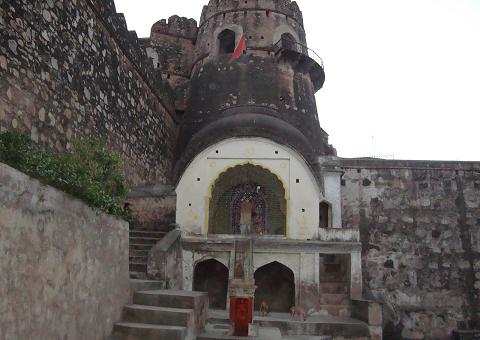 |
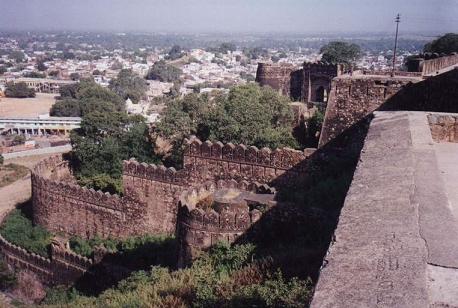 |
|
Jhansi Fort |
Jhansi Fort |
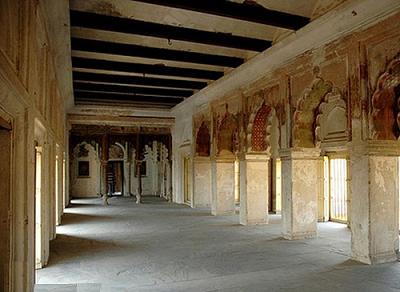 |
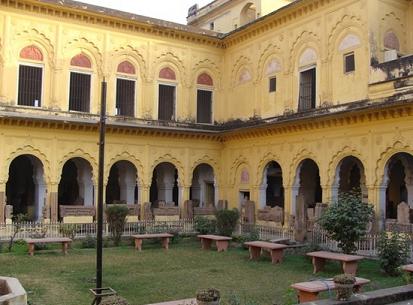 |
|
Rani
Mahal |
Rani
Mahal |
|
Tourist Excursions in Jhansi |
|
Todi Fathepur
The Todi Fathepur fort is built on a hillock. It covers an area of 5 acres
and is surrounded by three massive stone walls. This fort is divided into
four major parts known as Gusain Mahal, Ranwas, Rajgarh Palace and the
Rang Mahal Palace.
Samthar
Distance from Jhansi = 66 Km. Samthar which was formerly know as
Samshergarh. Samthar was an independent principality under the great Gujar
warriors. The independent state of Samthar was created by Chandrabhan Bar
Gujar and his grand son Madan singh, Governors of the state of Datia.
Datia (M.P.)
Distance from Jhansi = 28 Km. Datia, an ancient town, mention in the
Mahabharat as "Daityavakra". It is a pilgrimage spot for devotees of
Siddhapeeth Shri Peetambra Devi. The other places of interest are
seven-storied palace of Raja Bir singh Ju Deo built atop a hill and the
Gopeshwar Temple.
Aricha Dam
Distance from Jhansi = 25 Km on the Jhansi-Kanpur National Highway No.25.
Paricha Dam is built on the river Betwa. Its reservoir - a placid stretch
of water that runs to Notghat Bridge which is 34 Km. away. This is an
ideal place not only for water sports but also for adventure seekers and
picnickers. The whole area is rich in scenic beauty and holds the promise
of an unforgettable holiday.
Baruasagar
Distance from Jhansi = 24 Km. (approx) on the route to Khajuraho.
Baruasagar named after a large lake called Baruasagar Tal. This lake was
created about 260 years ago when Raja Udit Singh of Orcha erected and
embankment. A fort was built by him. The ruins of two old Chandela
Temples, made of granite, are on the north-east of the lake. The older one
is called Ghughua Math. Nearby is the later Gupta period temple called
Jarai-Ka-Math. This is dedicated to Lord Shiva and Devi Parvati.
|
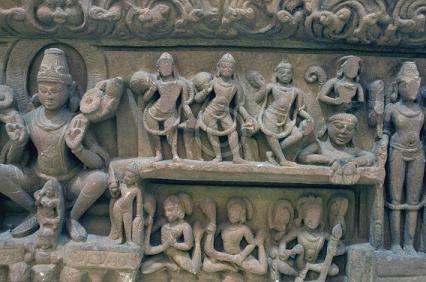 |
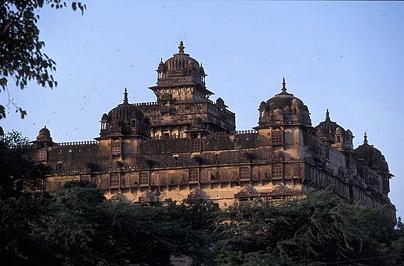 |
|
Jhnasi
Museum |
Datia |
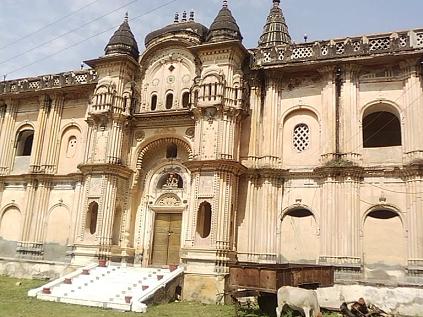 |
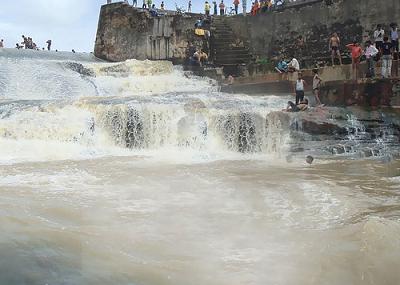 |
|
Samthar |
Baruasagar |
|
|
By Rail:
Jhansi is well connected to major cities of country by regular trains.
The nearest railway station for Deogarh is Jakhalaun about 13 km,
which can be reached by Jhansi-Babina passenger train.
By
Road:
Jhansi is well connected with a good network of roads. Jhansi is
located on the National Highways 25 and 26. It is also connected with
all major cities like Agra, Orchha, Datia, Lucknow, Delhi and
Khajuraho.
By Air:
No regular flights operate from other major cities of the country to
Jhansi. The nearest airports is located in Gwalior, about 98 km from
Jhansi. |